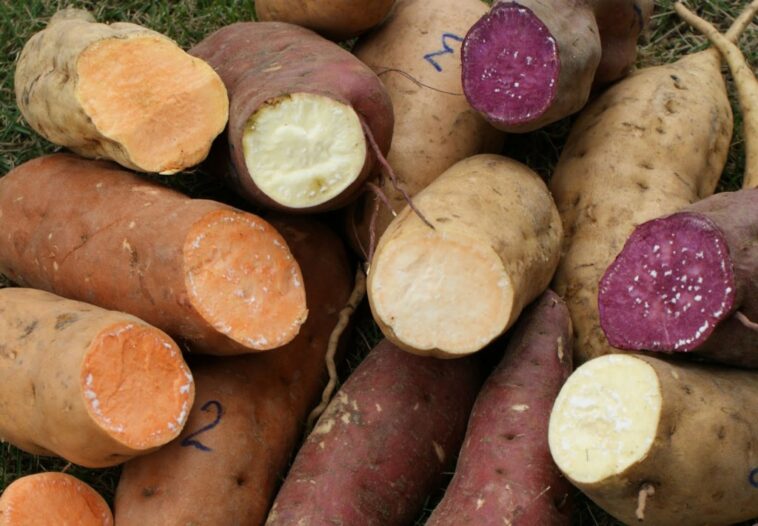What Are Camotes?
 Camotes are a breed of sweet potatoes found throughout central and south america. Here in Costa Rica, you’ll find the most common types are purple with a light-colored interior. There are also “camote de oro” or “golden camotes” which are more popular in Nicaragua. (In my opinion, these golden camotes make the best sweet potato fries.) The camote’s taste is a bit different from traditional sweet potatoes in the United States but they can be used in the same way. Camotes and traditional sweet potatoes fall under the same species name, Ipomoea batatas. Sweet potatoes and camotes are a high calorie starch food that provides 90 calories per 100 g verses to 70 calories per 100 g in potato. The tuber is rich source of dietary fiber, anti-oxidants, vitamins, and minerals. Its calorie content comes from starch, a complex carbohydrate.
Camotes are a breed of sweet potatoes found throughout central and south america. Here in Costa Rica, you’ll find the most common types are purple with a light-colored interior. There are also “camote de oro” or “golden camotes” which are more popular in Nicaragua. (In my opinion, these golden camotes make the best sweet potato fries.) The camote’s taste is a bit different from traditional sweet potatoes in the United States but they can be used in the same way. Camotes and traditional sweet potatoes fall under the same species name, Ipomoea batatas. Sweet potatoes and camotes are a high calorie starch food that provides 90 calories per 100 g verses to 70 calories per 100 g in potato. The tuber is rich source of dietary fiber, anti-oxidants, vitamins, and minerals. Its calorie content comes from starch, a complex carbohydrate.
The Sweet Potato With Many Names
These are all in the species, “Ipomoea batatas”, however they go by many names. Camote, Boniato, batata, Cuban sweet potato, white yam, Florida yam, kamote, Caribbean sweet potato, or kumara to name a few. The version of the sweet potato in the image has many names: boniato, batata, Cuban sweet potato, white yam, Florida yam, kamote, Caribbean sweet potato, or kumara. While some names include the word “yam”, these NOT yams or related to yams.
Health Benefits of Camotes
The Camote also has higher amylose to the amylopectin ratio than that in potato. Amylose raises the blood sugar levels slower than simple fruit sugars (fructose, glucose etc) and is recommended as a food option for diabetics. It’s low glycemic effect also makes the Camote a great option for those on lower carbohydrate or paleolithic diets. The camote tops or “sweet potato greens” are excellent sources of antioxidative compounds, mainly polyphenols. These may protect the human body from oxidative stress that is associated with many diseases including cancer and cardiovascular diseases.
An interesting study by Georgia State University found that the Polyphenol-rich sweet potato greens inhibit proliferation and induce cell death in prostate cancer cells in vitro and in vivo. You can download the PDF in the sources section at the bottom of the page. Also, be sure and check out our post on eating sweet potato greens.
Camotes are an excellent dual purpose crop. The leave or “tops” can be eaten like spinach and constantly regrow. They’re great raw in salads or tossed into soups and stews. The tasty roots are an excellent starch option for a survival garden. They are packed with essential vitamins such as Pantothenic acid Vitamin B-5, Vitamin B-6, and Vitamin B-1, Niacin, Vitamin A and Riboflavin. These vitamins work to help the body’s metabolism and energy production.
How To Grow Camotes
First, camotes can’t survive frost, and like sweet potatoes they’re often considered a

tropical crop. So if you don’t live in a warm climate, it’ll be difficult to keep a continual crop supplying the household.
The easiest way that I’ve found to plant them is to get a hold of some cuttings. You can place them in the ground with some leaves exposed and keep them watered until they root, or you can place the cuttings in water and let them good root development and plant them when you want. You can also root camotes like the picture on the right. Just be sure to change the water daily or they’ll rot. We root all of our camote plants from vine cuttings in our aquaponics system. It takes about a week for roots to develop and they’re ready to go in the ground. Because the rapidly growing vines shade out weeds, little weeding is needed. In the tropics, the crop can be maintained in the ground and harvested as needed for home consumption. In temperate regions, sweet potatoes are most often harvested before first frosts.
After planting, keep them watered and they’ll spread. They like sandy loose soil and they can handle the full sun. After they’ve developed and spread a bit, they handle a lot of neglect.
I suggest planting camotes because they’re a lazy man’s crop. The Survival Gardener mantra, “minimum input, maximum output” certainly rings true with Camotes. Their perennial vining nature make them easy to propagate and able to keep growing and producing year round. They require little water and can handle neglect. Camotes can also be used as groundcover, living mulch or for weed control.
Below is an image of a patch I planted under my water tanks and forgot. What a productive survival crop!

Sources and Links
Encyclopedia of Life Entry on Camotes and Sweet Potatoes




GIPHY App Key not set. Please check settings
One Comment